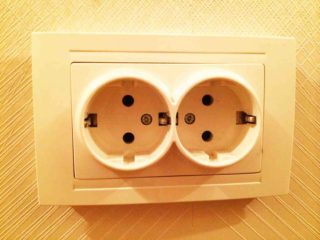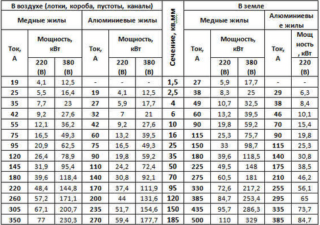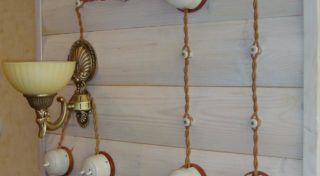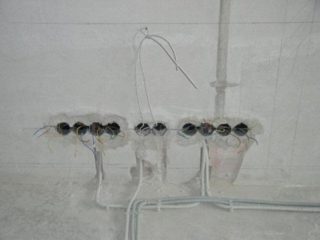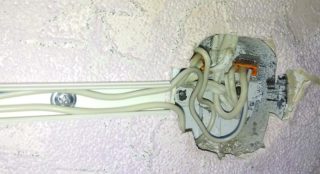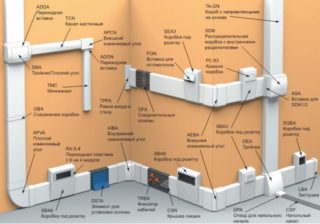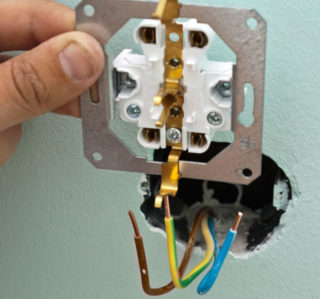In modern conditions, a person uses a large number of electrical appliances. All of them require connection to an electrical outlet, but it is not always possible to connect all devices to the network in a room. For temporary connection, the best way out is to use a household extension cord or alteration of the power point. Installing two sockets instead of one outlet is a simple task, but it is not always technically resolved. Before the reconstruction, you should familiarize yourself with the features and nuances of how to make two out of one outlet.
Advantages and disadvantages
Plus, the connection schemes for one or more electrical outlets to the main power point are convenience. The user will not worry that there is not enough space to connect, wires or a drop-out tee will not interfere with him.
But such a connection has disadvantages. The main minus is the ultimate load. Typically, outlets use wires with a cross section of 1.5 or 2.5 square meters. Such cables are designed for a certain power of connected devices. If there are more connectors for connecting the equipment, the load will increase and the wires may fail.
All electrical outlets are additional resistance to electric current. If you connect a powerful appliance to the last outlet connected to the main power point, the previous contacts may heat up. Also, under the influence of an electric current, vibration will occur that degrades the quality of the connection.
It is not advisable to make such a connection in the kitchen, where all powerful household appliances that consume from 1.5 kW of electricity are assembled. For the same reason, it is dangerous to connect the power point in the bathroom.
Choosing the right wiring method
All ways to power from an outlet for another outlet can be divided into several groups. By the method of fixing - inside the wall, outside or from the external part of the main power point with the output of the wires to the outside. Further work is done in a similar way.
Highlights:
- Cable thickness. The cross section of the child outlet must not be less than the parent.
- Design decision. It directly depends on the interior of the room and does not affect the technical characteristics.
- Connection order. Home appliances can have two or three contacts. In the first case, these are phase and neutral wires, which are connected to different contacts. With a three-wire connection, grounding is added. It is connected to a mounting bolt on the device body.
- Grounding If it is available in the main power outlet, there should also be power at subsequent power points. According to the requirements of the PUE, the cable must be integral.
An additional power point is connected in parallel. But for lighting devices on the balcony, you can make a serial connection.
Outdoor wiring
It is applied in wooden houses or in rooms in retro style.
In a wooden house, wiring is laid in copper pipes. This is due to fire safety requirements, since cables must not be laid on wooden walls. This is a complex type of connection that requires additional locksmith work.
For retro wiring, the visual component is of utmost importance. If you connect another to one outlet, you can disrupt the picture created by the designer.In this case, to maintain the style, it is better to establish a new power point. If this method is not possible, an additional outlet is installed next to the old one on the same dielectric substrate. It is important to choose the same outlet in style so as not to disturb the appearance.
Concealed wiring
With this installation, all wires are hidden in the wall. Even at the stage of repair work, special grooves are cut into which the cables are laid. After the strobes are sealed with gypsum or cement and begin decorating.
If you need to put an additional power outlet from an existing power point, you should find out if it is possible to cut another stroba and make a hole for a socket.
Mounting the outlet block
Such a connection is used if it is not necessary to make a new point at a distance from the main one. A hole is made near the first outlet on the wall, inside which the wires are hidden. If the work is done carefully, the finish will not be damaged or broken. Since the size of the decorative cover is larger than the socket, all internal details and traces of cutting through the wall will be invisible.
Combined Wiring
This method is used when additional ones need to be connected from one electrical outlet, and walls cannot be drilled. The installation and connection of wires in this case is as follows:
- Power outage. It is necessary to turn off the entire apartment or the room in which the work will be carried out. Using a tester, you need to make sure that there is no voltage.
- Removing the protective cover from the main power point.
- Removing the outlet by loosening the holding contacts.
- Connect wires to a new power point.
- Next, it is checked whether the limiter will push the wires. If it interferes with the cables, you need to carefully break off a small piece from the socket or wall to the size of the wire.
- Installing the outlet in place.
- Create a hole in the decorative cover for the wire.
- Lid installation.
The wire is led to the desired power point and attached to the wall with brackets every 30 cm.
How to hide a wire
The method of fixing the power outlet depends on its use. It can be screwed to the baseboard or left as a carry. This method is used for outdoor products. Cables can be hidden in a special cable channel, which is glued to the wallpaper or fixed between the baseboard and the socket cover.
If the socket is installed for a long period, the wires can be hidden under a layer of plaster. If the wall is glued with wallpaper, they can be cut along the laying line. Next, you need to carefully peel off a small part of the wallpaper and make a hole for the cables in the wall. Wires are laid in a done furrow, putty and covered with wallpaper.
Drywall Installation
Installing power points in drywall is both hidden and open wiring. The wires are invisible to the eye, as in hidden electrical wiring, but at the same time they are not located inside the wall and can be reached, as for open installation. For work, professional tools and steel wire are needed.
How to make several from one outlet:
- Removing the outlet and the socket from the wall.
- Threading steel wire into the hole in the direction of installing a new power point. This is done in order to make sure that between the profile and the wall you can install a corrugated pipe with a cable.
- Drilling a place for a new socket.
- To the wire you need to scroll the rope and pull it back.
- A corrugated pipe is drawn between two outlets with a rope.
- Wires stretch into the corrugation.
The final step is to connect the electric wires.
There are times when there is no space between the wall and the profile for the corrugation.Then you have to unscrew the sheet of drywall, pull the cables for a new outlet and install everything in place. Joints need to be putty and put a new power point.
Which way to choose
The choice of the desired method from the outlet to make two outlets depends on the individual characteristics of each room, installation location, the total load of the connected devices.
A prerequisite for any installation method is to ensure high-quality and reliable contact between the wires.
Main mistakes
Installing an additional outlet is usually straightforward. But beginners can make the following mistakes:
- Wrong choice of wire cross-section. Need a cable of the same thickness as the main outlet.
- Using wire made from another material. The connection of two different wires causes additional difficulties, and the contact itself is less reliable.
- Violation of the sequence of connecting wires. Particular attention should be paid to the grounding conductor. If it is absent in the house (especially in old buildings), it is better to purchase sockets without land.
- Insecure contact. You need to familiarize yourself with the existing methods of creating a contact in advance and practice connecting to spare wires.
- Installing wires diagonally. Standards allow only vertical cabling.
There is also a risk of buying an unsuitable design model. This is not a critical mistake from a technical point of view, but may violate the general concept of the room. Therefore, when buying, it is recommended to pre-select the color of the product, its shape and size. Manufacturers of electrical products offer a wide range of products, any buyer will find a product that suits the style.
